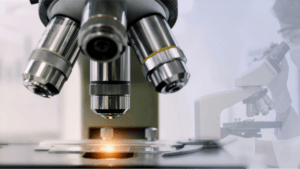Trajan’s Mitra tech takes gentler blood testing mainstream

Mitra is gentler on young patients, where it can eliminatethe need to draw blood with a needle. Pic: Getty Images.
- Trajan’s flagship dried-blood microsampling device Mitra starts the shift from early adoption to mainstream clinical use
- In some cases the device can eliminate the need to draw blood with a needle, and cold storage of sample, expanding access and convenience in blood testing
- Especially beneficial in paediatric and remote healthcare
Special Report: Melbourne-headquartered Trajan’s flagship dried-blood microsampling device Mitra has moved from early adoption to mainstream use, offering gentler blood collection for patients and starting to deliver financial returns.
Built on Trajan Group Holdings’ (ASX:TRJ) proprietary Volumetric Absorptive Microsampling (VAMS) technology, Mitra allows lab-quality blood samples to be collected anywhere – without a needle, cold storage or travel to a clinic.
High gross margins and scalability underpin the device’s revenue growth, with repeat orders rising steadily across recent quarters.
Pandemic-driven momentum
Trajan vice president Corinna Rockenbach said the Covid-19 pandemic was a turning point for Mitra.
“Suddenly, the need for safe, reliable ways to collect samples outside of hospitals and clinics became urgent, and Mitra was ready to meet that demand,” she said.
“At the same time, the scientific foundation had been steadily building, with more than 400 peer-reviewed publications validating Mitra’s reliability, showing everything from biomarker stability to correlation with venous blood draws.”
She noted momentum really accelerated with the National Institute of Health’s large-scale serology study, which enrolled nearly 10,000 participants.
“The fact that fewer than 1% of samples were rejected gave the industry confidence that Mitra could perform at scale.”
With Class I (Australia) and CE-IVD (Europe/UK) approvals in hand, Mitra can now be used for both clinical and home-based collection, supporting decentralised trials and broad-based monitoring.
“For customers, these approvals provide the confidence that the device has been through rigorous quality, stability studies and safety assessments,” Rockenbach said.
“For Trajan, they open the door to wider adoption, particularly in regulated clinical environments and international markets.”
Gentler care for young patients
Rockenbach said in neonatal care and paediatrics, Mitra enabled clinicians to work with smaller sample volumes, reducing the pain of traditional blood draws.
For immunocompromised individuals, it provides a safer way to be monitored remotely, minimising unnecessary exposure and long waits in hospitals or clinics.
In rural communities, patients don’t have to spend hours traveling to the nearest lab or lose a day of work or school for routine testing.
Remote monitoring also makes it easier for doctors to track things like drug metabolism and toxicity in real time.
And by lowering barriers to care, Mitra helps bring healthcare within reach for populations that are often underserved.
Global adoption
In Poland, the Medical University of Warsaw and Children’s Memorial Health Institute use Mitra to monitor drug levels in children’s blood
“A quick finger prick – like how blood glucose is tested – is enough, and only a tiny drop of blood is needed,” Dr Arkadiusz Kocur, pharmacist and researcher said.
“For the first time in Poland, we used both the Mitra device and a laboratory method we developed at the Medical University of Warsaw to measure the level of the drug tacrolimus in children after kidney transplantation.
“Checking the level of this drug is very important because taking too much can cause side effects, while taking too little can make it less effective.”
In France, the Centre Hospitalier Universitaire de Limoges has also adopted Mitra for an easy way to track tacrolimus levels using AUC-based therapeutic drug monitoring.
Researcher Caroline Monchaud said this needs at least three blood samples over a three to four-hour period, which requires the patient to stay in the lab or hospital for that period. However using Mitra devices “offers the possibility for the patient to collect the samples in autonomy, at home.”
Improving workflow and efficiency
Since using Mitra for routine testing, Dr Kocur said workflow had become much smoother and more efficient, with the most significant benefit enabling reliable monitoring of multiple drugs and biomarkers remotely.
“When we first started working with Mitra in immunosuppressive therapy for children, it opened the door to developing new analytical methods that have now become part of our daily practice,” he said.
“What’s exciting is that these methods are helpful not only for remote monitoring but also in intensive care units, where patients undergo numerous tests, and every drop of blood matters.”
Kocur noted that being able to reduce the amount of blood needed while still obtaining accurate results was a significant advantage.
“Ultimately, it all comes down to one thing – making care safer, gentler, and less painful for our young patients – that’s something we’re truly proud of.”
A randomised trial found that extra monitoring of immunosuppressive therapy in paediatric kidney-transplant patients cut non-compliance from about 15% to 5% among those using Mitra.
“Some children actually enjoy using the device – one told us, ‘I’d like to keep collecting samples all the time because it doesn’t hurt, it’s easy, and I can do it at home.’”
Kocur said their studies showed that capillary blood collected with Mitra can be used interchangeably with traditional venous samples, and that results can be recalculated to match values from standard biological samples, such as plasma.
Strong margins and expansion opportunities
Rockenbach said the strength of Mitra’s margins comes from a mix of smart design and operations.
“On the production side, we’ve kept the device streamlined, which means we can manufacture large volumes of a few core part numbers efficiently,” she said.
“For logistics, we partner with specialised providers who specialise in kit customisation and mailing, so we don’t get bogged down in complexity.”
Rockenbach said underlying IP and know-how were proprietary and well protected, with competitors trying to copy it without success.
Looking ahead, Trajan is working to expand Mitra into other types of biofluids.
“VAMS – the technology behind Mitra – works not only with dried blood but also with other biofluids like plasma, urine, and even tears, which opens the door to entirely new testing categories,” she said.
There’s also a clear role in personalised medicine, she added – especially through metabolomic profiling that could help tailor treatment plans to individual patients.
“Perhaps most exciting, Mitra has the potential to reshape preventive healthcare by making routine health screenings something people can do from home,” Rockenbach said.
“The vision is to move medicine from reactive to proactive – and Mitra is the platform that can help make that happen.”
This article was developed in collaboration with Trajan Group Holdings, a Stockhead advertiser at the time of publishing.
This article does not constitute financial product advice. You should consider obtaining independent advice before making any financial decisions.
Related Topics

UNLOCK INSIGHTS
Discover the untold stories of emerging ASX stocks.
Daily news and expert analysis, it's free to subscribe.
By proceeding, you confirm you understand that we handle personal information in accordance with our Privacy Policy.








